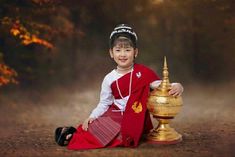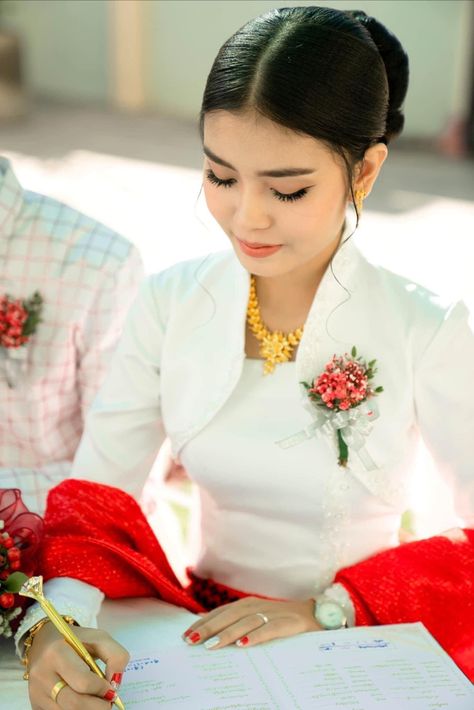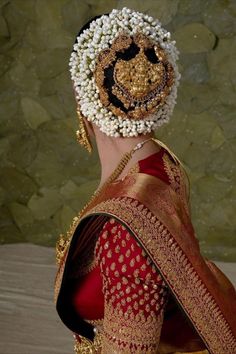South Indian Buddhist Bridal
South Indian Buddhist bridal ceremonies are a harmonious blend of spirituality, tradition, and cultural heritage. Rooted in ancient customs and beliefs, these weddings are characterized by elaborate rituals, vibrant attire, and intricate adornments. In this class note, we embark on a journey to explore the enchanting world of South Indian Buddhist bridal traditions, unraveling the rituals, attire, jewelry, and customs that make them unique and cherished.

Rituals and Ceremonies: The journey of a South Indian Buddhist bride towards marriage is marked by a series of rituals and ceremonies, each laden with symbolic significance. The pre-wedding rituals typically commence with the Nischayathartham ceremony, where the formal engagement takes place, followed by the Lagna Patrika ceremony, where the wedding date and auspicious timings are determined.
On the auspicious day of the wedding, the bridal procession, known as the Baraat, heralds the groom’s arrival at the wedding venue. The groom, accompanied by his family and friends, is welcomed with joyous celebrations, traditional music, and colorful decorations.
The main wedding ceremony, known as the Vivah Sanskar, is conducted according to Buddhist traditions, with the chanting of sacred mantras, prayers, and rituals performed by the Buddhist priest. The bride and groom exchange vows amidst the chanting of hymns, symbolizing their commitment to each other and their shared spiritual journey.

Attire and Adornments: The attire of a South Indian Buddhist bride exudes elegance, grace, and cultural heritage. The bride typically adorns herself in a resplendent silk saree or lehenga in hues of red, maroon, or gold, adorned with intricate embroidery, zari work, and embellishments. The bridal attire is often accompanied by a matching dupatta or odhani, draped gracefully over the head or shoulders.
One of the most captivating aspects of a South Indian Buddhist bride’s ensemble is her jewelry. The bride embellishes herself with exquisite pieces of gold jewelry, including necklaces, earrings, bangles, and anklets, symbolizing prosperity, purity, and marital bliss. Traditional Buddhist symbols such as the lotus, the conch shell, and the eternal knot are intricately woven into the jewelry designs, reflecting the bride’s spiritual beliefs and cultural heritage.
Makeup and Hairstyle: The makeup and hairstyle of a South Indian Buddhist bride are meticulously chosen to enhance her natural beauty while complementing her bridal attire. The bride’s makeup typically features soft, earthy tones, with a focus on accentuating her eyes and lips. Traditional bridal makeup techniques such as kohl-lined eyes, winged eyeliner, and matte lip colors are commonly employed to create a radiant and ethereal look.

For the hairstyle, South Indian Buddhist brides often opt for classic styles like the traditional bun adorned with fresh flowers or ornate hair accessories. Elaborate braids, twisted hairstyles, and elegant updos are also popular choices, adding a touch of sophistication to the bride’s overall appearance.
Customs and Traditions: Beyond the attire and adornments, South Indian Buddhist bridal ceremonies are steeped in customs and traditions that have been passed down through generations. These customs not only add depth and meaning to the wedding ceremony but also serve to strengthen familial bonds and community ties.
One such custom is the Kanyadaan ceremony, where the bride’s parents formally give her away to the groom, symbolizing the transfer of responsibility and care from the parental home to the marital home. This ritual underscores the significance of family bonds and the role of parents in shaping the future of their children.
Another important custom is the Saptapadi or Seven Steps, where the bride and groom take seven steps together, symbolizing their journey through life as partners and equals. With each step, they recite vows and promises to each other, reaffirming their commitment and love.

Conclusion: The South Indian Buddhist bridal tradition is a celebration of love, spirituality, and cultural heritage, where every ritual, attire, and custom holds deep symbolic significance. From the elaborate wedding ceremonies to the exquisite bridal attire and jewelry, every aspect of the Buddhist bridal tradition reflects the community’s rich cultural heritage and timeless traditions. As Buddhist weddings continue to evolve with the times, they remain rooted in the values of compassion, harmony, and spiritual growth, making them truly memorable and cherished occasions for all involved.



